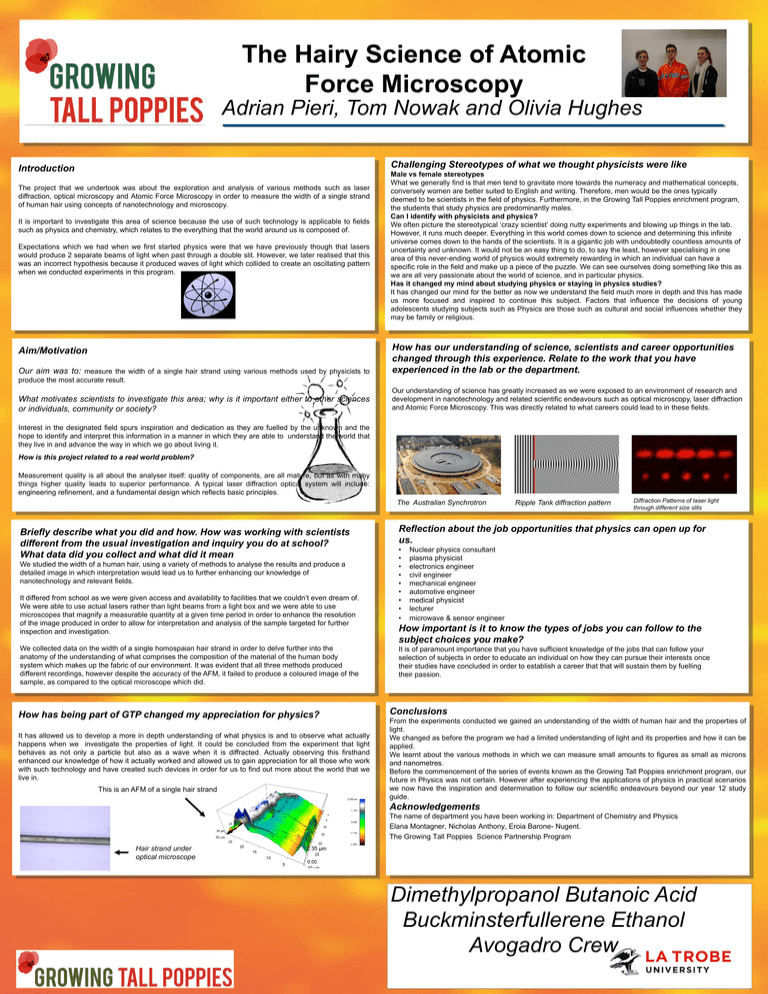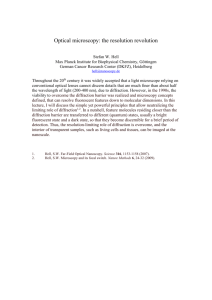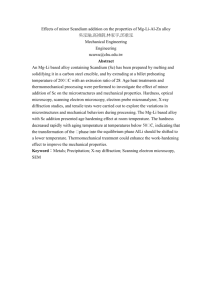Student Poster - Growing Tall Poppies
advertisement

The Hairy Science of Atomic Force Microscopy Adrian Pieri, Tom Nowak and Olivia Hughes Challenging Stereotypes of what we thought physicists were like Introduction The project that we undertook was about the exploration and analysis of various methods such as laser diffraction, optical microscopy and Atomic Force Microscopy in order to measure the width of a single strand of human hair using concepts of nanotechnology and microscopy. It is important to investigate this area of science because the use of such technology is applicable to fields such as physics and chemistry, which relates to the everything that the world around us is composed of. Expectations which we had when we first started physics were that we have previously though that lasers would produce 2 separate beams of light when past through a double slit. However, we later realised that this was an incorrect hypothesis because it produced waves of light which collided to create an oscillating pattern when we conducted experiments in this program. Aim/Motivation Our aim was to: measure the width of a single hair strand using various methods used by physicists to Male vs female stereotypes What we generally find is that men tend to gravitate more towards the numeracy and mathematical concepts, conversely women are better suited to English and writing. Therefore, men would be the ones typically deemed to be scientists in the field of physics. Furthermore, in the Growing Tall Poppies enrichment program, the students that study physics are predominantly males. Can I identify with physicists and physics? We often picture the stereotypical ‘crazy scientist’ doing nutty experiments and blowing up things in the lab. However, it runs much deeper. Everything in this world comes down to science and determining this infinite universe comes down to the hands of the scientists. It is a gigantic job with undoubtedly countless amounts of uncertainty and unknown. It would not be an easy thing to do, to say the least, however specialising in one area of this never-ending world of physics would extremely rewarding in which an individual can have a specific role in the field and make up a piece of the puzzle. We can see ourselves doing something like this as we are all very passionate about the world of science, and in particular physics. Has it changed my mind about studying physics or staying in physics studies? It has changed our mind for the better as now we understand the field much more in depth and this has made us more focused and inspired to continue this subject. Factors that influence the decisions of young adolescents studying subjects such as Physics are those such as cultural and social influences whether they may be family or religious. How has our understanding of science, scientists and career opportunities changed through this experience. Relate to the work that you have experienced in the lab or the department. produce the most accurate result. What motivates scientists to investigate this area; why is it important either to other sciences or individuals, community or society? Our understanding of science has greatly increased as we were exposed to an environment of research and development in nanotechnology and related scientific endeavours such as optical microscopy, laser diffraction and Atomic Force Microscopy. This was directly related to what careers could lead to in these fields. Interest in the designated field spurs inspiration and dedication as they are fuelled by the unknown and the hope to identify and interpret this information in a manner in which they are able to understand the world that they live in and advance the way in which we go about living it. How is this project related to a real world problem? Measurement quality is all about the analyser itself: quality of components, are all mature, but as with many things higher quality leads to superior performance. A typical laser diffraction optical system will include: engineering refinement, and a fundamental design which reflects basic principles. The Australian Synchrotron Briefly describe what you did and how. How was working with scientists different from the usual investigation and inquiry you do at school? What data did you collect and what did it mean We studied the width of a human hair, using a variety of methods to analyse the results and produce a detailed image in which interpretation would lead us to further enhancing our knowledge of nanotechnology and relevant fields. It differed from school as we were given access and availability to facilities that we couldn’t even dream of. We were able to use actual lasers rather than light beams from a light box and we were able to use microscopes that magnify a measurable quantity at a given time period in order to enhance the resolution of the image produced in order to allow for interpretation and analysis of the sample targeted for further inspection and investigation. We collected data on the width of a single homospaian hair strand in order to delve further into the anatomy of the understanding of what comprises the composition of the material of the human body system which makes up the fabric of our environment. It was evident that all three methods produced different recordings, however despite the accuracy of the AFM, it failed to produce a coloured image of the sample, as compared to the optical microscope which did. How has being part of GTP changed my appreciation for physics? It has allowed us to develop a more in depth understanding of what physics is and to observe what actually happens when we investigate the properties of light. It could be concluded from the experiment that light behaves as not only a particle but also as a wave when it is diffracted. Actually observing this firsthand enhanced our knowledge of how it actually worked and allowed us to gain appreciation for all those who work with such technology and have created such devices in order for us to find out more about the world that we live in. This is an AFM of a single hair strand Ripple Tank diffraction pattern Diffraction Patterns of laser light through different size slits Reflection about the job opportunities that physics can open up for us. • • • • • • • • • Nuclear physics consultant plasma physicist electronics engineer civil engineer mechanical engineer automotive engineer medical physicist lecturer microwave & sensor engineer How important is it to know the types of jobs you can follow to the subject choices you make? It is of paramount importance that you have sufficient knowledge of the jobs that can follow your selection of subjects in order to educate an individual on how they can pursue their interests once their studies have concluded in order to establish a career that that will sustain them by fuelling their passion. Conclusions From the experiments conducted we gained an understanding of the width of human hair and the properties of light. We changed as before the program we had a limited understanding of light and its properties and how it can be applied. We learnt about the various methods in which we can measure small amounts to figures as small as microns and nanometres. Before the commencement of the series of events known as the Growing Tall Poppies enrichment program, our future in Physics was not certain. However after experiencing the applications of physics in practical scenarios we now have the inspiration and determination to follow our scientific endeavours beyond our year 12 study guide. Acknowledgements The name of department you have been working in: Department of Chemistry and Physics Elana Montagner, Nicholas Anthony, Eroia Barone- Nugent. The Growing Tall Poppies Science Partnership Program Hair strand under optical microscope Dimethylpropanol Butanoic Acid Buckminsterfullerene Ethanol Avogadro Crew www.coecxs.org







